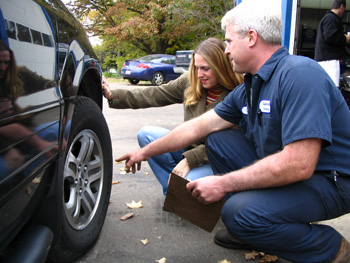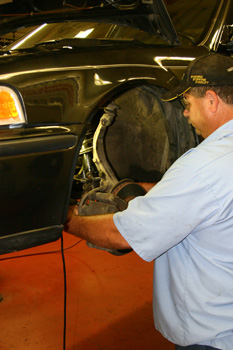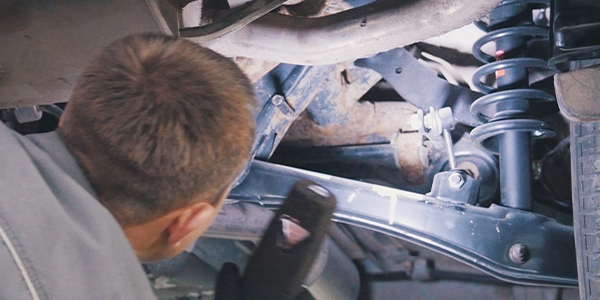 Many times I would estimate a set of four struts, and recoil in the amount of money it would cost. I would either neglect to mention it to the customer and go for the easy sale of items that would make the car either stop or go. If I was confident, I might have written the estimate on the customers bill in hopes they might come back.
Many times I would estimate a set of four struts, and recoil in the amount of money it would cost. I would either neglect to mention it to the customer and go for the easy sale of items that would make the car either stop or go. If I was confident, I might have written the estimate on the customers bill in hopes they might come back.
Leave your empathy, assumptions and personal budget at the door and tell the customer what new shocks and struts can do for them. You should never feel like a criminal when you recommend new shocks and struts. There are no fancy sales mind games when you just present the customers with the facts.
Never give up. It’s been estimated that 50% of ride control sales occur on the second visit. This means that a large percentage of first-time sales pitches for ride control are followed by, “Sorry, no thank you.” But, the customer comes back eventually.
Hearing “no” for anything builds up a subliminal roadblock that makes the person hesitant to sell shocks and struts. Soon, the ride control recommendation becomes more of a “feeler” question rather than a real sales proposal. The most destructive behavior is when the service writer begins to second-guess the customer and base his sales tactics on assumptions.
Don’t give up. When you spend the time to explain what was found during the inspection and test drive, you have planted a seed that will grow into a sale. The cultivation of this seed might take place on the way home from the shop when the customer notices excessive dive and roll.
An effective sales tactic when selling ride control is to start with premium products first rather than with the economy or less- expensive option. It can give you a little room to provide your customers with options that meet their budget and vehicle life expectancy. Chances are your customers want the best. Starting the estimate with the least expensive alternative can lower your profit. Quoting the lowest price might get some customers in the door, but it may leave some customers wanting more.
 Inspection
Inspection
The first step in selling ride control is the inspection process. A visual inspection of the shocks and struts can tell you a lot about the state of the ride control units and provides the opportunity to make sure the vehicle is road-worthy before you put your own life at risk.
Look for signs that the units might be leaking oil, such as the accumulation of road grime or the presence of oil inside the boots and dust shields. Also keep an eye out for “witness marks” that indicate the suspension might have bottomed out recently. Make sure all bushings and hardware for the ride control units are still on the vehicle.
Walk around the vehicle and perform the tried-and-true “knee-on-the-bumper” test. While the test is not conclusive on its own, it’s a chance to look for abnormal behavior. If you notice binding or looseness, or if the vehicle does not return to the original ride height, it could be a sign that there is a problem with the ride control components.
Test Drive
When going for a test drive, you should have a clear objective and methodical plan for inspecting the vehicle for ride control component replacement and other unperformed repairs. Before going on a test drive, make sure there is enough gas in the tank, and be sure to have a clear list of symptoms and related conditions the customer might be experiencing.
A good test driver will be able to observe conditions or problems with the vehicle that have developed so slowly the owner is unaware of them — like degraded shocks and struts. One of the keys to becoming a good test driver is to find a driving “loop” or route that has a variety of road conditions. Using a predetermined loop can help to build consistency that will help you be able to spot small problems. For suspension road tests, your test loop should consist of a variety of sections: a flat and straight section; an area to test braking and acceleration; an area with a dip or bump; and an area that offers both left and right turns.
Use a parking lot or rarely used section of road for your testing, during which time you will try to detect brake pull, torque steer and worn or loose suspension or steering components. Check for excessive nose-diving during braking, which is not normal and may be caused by worn springs or another worn ride control component. Excessive suspension bouncing may be the result of weak shocks. Bottoming out of the suspension may be the result of weak springs. Check for steering difficulties that may be the result of mechanical binding or interference.
Any excessive body sway could indicate worn springs, shocks or stabilizer assemblies. Listen for any excessive squealing of the tires during turns. This can be caused by incorrect alignment settings or a turning angle that’s out of specifications.
Developing a methodical and consistent test-drive loop and procedure can improve your chances of coming back from a test drive with a better understanding of the problem the owner is experiencing. Also, having a plan and a loop can eliminate distractions that could lead to an accident.
The technician should be supplied with a checklist to make notes. Some ride control manufacturers can provide printed forms, which can help the salesperson be more confident in the selling process.
A complete inspection lays the groundwork for excellent customer communications and increases the possibility of a sale. The results of the inspection, documented on paper, can help personalize the sales pitch to the individual customer.
The Estimate
Even if the customer does not buy today, the inspection form sales approach and pitch will likely stick with the consumer longer than the generic “recommend new shocks and struts” listed on an estimate. This means that he/she might be back and your efforts will not be in vain.
The following is an example of how a note on an inspection form can increase customer education and move them to action.
Salesperson: “On the test drive, the technician noticed excessive nose dive during braking and increased body roll while turning. Also, we noticed humming coming from the rear that was caused by uneven wear of the rear tires.”
Customer: “I guess it’s not exactly performing the same as it was when new and that humming noise was starting to annoy me.”
Salesperson: “New struts can help return the vehicle to like it was when it was new. They can also prevent future uneven wearing of your tires.”
In this simple salesperson/ customer dialogue, the information gained in the test drive helped to identify and define the value of new ride control components to the customer. Also, the information given to the customer helped to create a tangible need that he can relate to regarding why the service should be performed.
Try Them for Yourself
To increase your confidence in selling shocks and struts, have new units installed on your own vehicle. You’ll be amazed at the difference if your vehicle has more than 50,000 miles on the odometer. Also, you will sell more units because you have a better view of the perceived value.
Some ride control manufacturers hold local clinics where you can drive vehicles in different states of ride control degradation. These events are typically held in parking lots on specially designed courses that magnify the certain vehicle dynamics at low speeds. These events can help to energize your staff to more effectively sell ride control products.
Ride Height
Ride height is a critical diagnostic measurement that can determine the health of the ride control components, springs and attached hardware. Measuring ride height is more than stepping back and visually measuring with your thumb and one closed eye.
To properly measure the ride height, the factory methods and specs must be researched. Neglecting this step can affect the life of the shocks and struts, and all alignment angles. Among other considerations, engineers design the chassis and ride control components so that the ride height places the suspension at a particular point midway in its travel. Midway is not always center, however. Most springs are made of metal, and will eventually break from metal fatigue, just like a coat hanger that’s bent in the same area several times.
It has been estimated by one ride control manufacturer that 80 percent of vehicles in junkyards still have their original shocks or strut units. Selling shocks and struts is not easy. If a salesperson can be confident in his sales procedure and information he can present the customer, he can take the worst rejection by a customer in stride.
Tire Sales
By the time a vehicle is ready for its second or third set of tires, it’s time for new ride control components. This is based on mileage and the premature wear that degraded ride control can cause on the new tires. Also consider, how can a consumer get the best performance from a new set of tires if the shocks and struts are not up to snuff?
Too many shops leave too much money on the table by not pursuing ride and stability control issues. Customers often notice that their imports are bouncing higher on the dips and bumps and swaying a little more on the sharp corners, but are often at a loss to explain that issue to service writers who might be more intent on selling wiper blades and washer fluid on routine service stops.
It’s important for a technician to notice if a vehicle has a rebound control problem when he drives the vehicle into the service bay. If the vehicle has more than 50,000 miles on the odometer, it’s time to take ride and stability control issues seriously. If the vehicle has more than 100,000 miles on the odometer, it’s very likely that one or more struts or shocks are worn or leaking fluid. If the vehicle is approaching 200,000 miles with the original struts and shocks in place, there should be no question of the need for their replacement.












